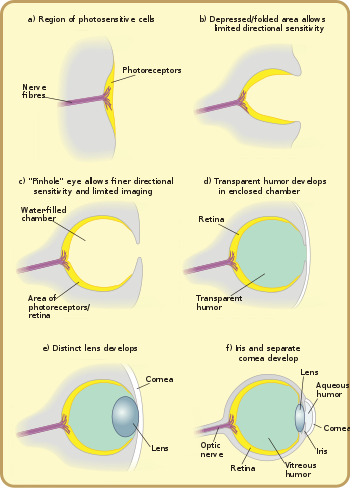A single system which is composed of several interacting parts that contribute to the basic function, and where the removal of any one of the parts causes the system to effectively cease functioning
Those who aren't familiar with the evolution of the eye often cite it as an example. I find this to be a weak example of intelligent design anyway, given the fact that our eye is subject to so many flaws. Cataracts, glaucoma, color blindness, near/far-sightedness, how are our eyes held up as an example of the best design by anyone? Below is a chart of the evolution of the eye, from a patch of photoreceptor cells to our eye.
Of course there are variations in these eyes as well and that's the interesting part I wanted to share with you today. We see more colors than our dogs because instead of 2 types of color photoreceptor we have 3. That one extra type of receptor allows us to perceive a much wider range of colors. Now while that may lead to arguments as to what color to paint the kitchen, it lets us enjoy all the colors we see in the rainbow. But, while our 3 types of receptors are great, most butterflies actually have 5 types of receptors, allowing them to see ultraviolet and infrared light.
So our eye is in some ways "less complete" or has one less part, but it does not cease to function, it just functions differently. When it comes to number of receptors though, the butterfly is not the king. That honor goes to the Mantis Shrimp.
The mantis shrimp has 16 different types of receptors and can see in ways that would be difficult to imagine. Radiolab has an episode all about color and there is a segment that discusses the rainbow and particularly how differently dogs, human, butterflies, and mantis shrimp would see it. You can listen to it here and if you want to get right to the rainbow section skip to about 9:40. It's about 10 minutes long from there, but well worth the listen.
What do you think?
Would you want more receptors or the ability to see ultraviolet or infrared?

No comments:
Post a Comment